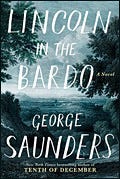Short but deep, Lincoln in the Bardo uses a real historical event, the death of President Lincoln's beloved son Willie, to delve into the nature of grief, remorse and grace. The author collects and arranges excerpts of contemporary accounts of Lincoln's presidency to exceptional effect, particularly the varying, even contradictory descriptions of the reception held in the White House in February of 1862 while Willie and his younger brother Tad lay ill upstairs with what was probably typhoid fever. Most of the novel, though, takes place in the Oak Hill Cemetery where Willie would soon be interred, and where a cast of fictional dead characters refer to their "sick-boxes," recall the accidents and illnesses which precipitated their arrival in the cemetery, and fear the afterlife.
Although the Tibetan word Bardo is not used or explicitly defined in the course of the novel, many readers will quickly understand the nature of the self-induced limbo in which the cemetery's inhabitants find themselves. Bardo is the transitional state preceding rebirth in which, according to the beliefs of some Buddhists, the soul exists after death. Readers need not know anything about Buddhism or believe anything in particular about an afterlife to appreciate the novel's insights about mourning and life in general.
Perhaps the most remarkable thing about this novel is how playful it is, without in any way diminishing its respect for the grieving process, for the enormous tragedy of the Civil War, and for the heartbreaking tragedy of young Willie’s death. Though Lincoln's point of view is not intimately developed until late in the novel, all that goes before lays the foundation for the deepening of his character through an acceptance of the mystery of suffering. Lincoln in the Bardo very credibly suggests that it made Lincoln into a wiser man and altered the course of American history. (2017, 368 pages)




